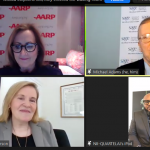En español | The odds of contracting a severe case of COVID-19 appear to be greater for American adults who identify as gay, lesbian or bisexual than for heterosexuals, according to a new report released by the U.S. Centers for Disease Control and Prevention (CDC).
In the study, published in Morbidity and Mortality Weekly Report, CDC researchers found that a greater proportion of gays, lesbians and bisexuals than heterosexuals report having underlying health conditions and behaviors associated with a higher risk of contracting severe COVID-19 illness.
The disparity existed across all the underlying conditions and behaviors for gays, lesbians and bisexuals, although not equally. The top 11 in ranked order were: current asthma sufferers, chronic obstructive pulmonary disease (COPD), kidney disease, current smokers, past asthma sufferers, stroke, cancer, heart disease, diabetes, obesity and hypertension.
The study also found that disparities differed when race and ethnicity were considered. In particular, the study found among Hispanics a substantially wider gap in the proportion of gays, lesbians and bisexuals with underlying conditions. The study also found variations in how the underlying conditions and behaviors stacked up within racial and ethnic communities:
- For whites, the top conditions (in ranked order) were: current asthma sufferers, kidney disease, COPD, current smokers and past asthma sufferers.
- Among Blacks, the top conditions (in ranked order) were: kidney disease, COPD, stroke, current asthma sufferers, current smokers and past asthmas sufferers.
- For Hispanics, the top conditions (in ranked order) were: COPD, current asthma sufferers, stroke, past asthma sufferers and current smokers.
- For others, including Asians and American Indians/Alaskan Natives, the top conditions (in ranked order) were: current asthma sufferers, stroke, cancer, heart disease and past asthma sufferers.
Black, Hispanic LGBTQ+ adults ‘of particular concern’
The researchers note that Blacks and Hispanics in the U.S. have already been shown to be disproportionately affected by the pandemic. In addition, stigmatization and discrimination faced by people because of their sexual orientation can make members of the LGBTQ+ community especially vulnerable to illness due to, among other reasons, lack of economic security and limited access to health care. The combination is “of particular concern,” researchers say.
“Persons who are members of both sexual minority and racial/ethnic minority groups might therefore experience a convergence of distinct social, economic, and environmental disadvantages that increase chronic disease disparities and the risk for adverse COVID-19–related outcomes,” the report says.
More LGBTQ+ data needed
A recent report commissioned by AARP New York and SAGE similarly found that older LGBTQ+ New Yorkers face steeper barriers to health care than their non-LGBTQ+ counterparts that put them at risk of experiencing COVID-19 more acutely, including: poor physical and mental health, alcohol and tobacco use, HIV, and cancer. The report, which also received support from AARP Foundation, found that about 40 percent of LGBTQ+ respondents in their 60s and 70s reported that their health care provider did not know about their sexual orientation.
“Inclusion of sexual orientation and gender identity data in COVID-19 surveillance and other data collections could improve knowledge about disparities in infections and adverse outcomes among sexual and gender minority populations, overall and by race/ethnicity,” the CDC report says.
For the study, CDC researchers combined data from three years of health-related telephone surveys (2017-2019) conducted in up to 31 states that included a question about sexual orientation. Among the combined 643,956 survey participants, 4.7 percent identified as gay, lesbian or bisexual. The study notes that the number of respondents identifying as transgender or nonbinary was too small for reliable estimates.
This article was originally published in AARP on February 8, 2021.






